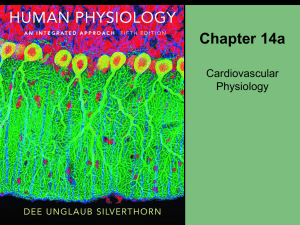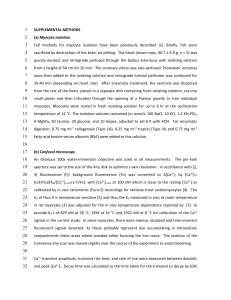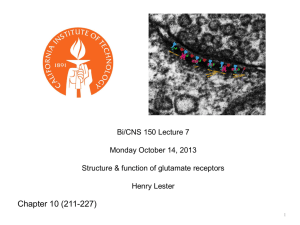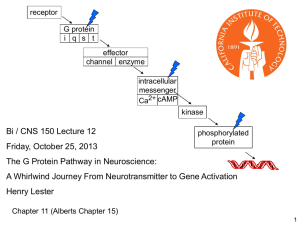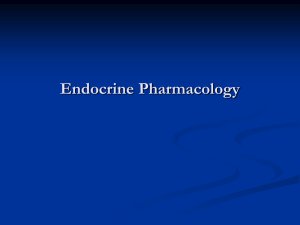SECOND MESSANGERS - MBBS Students Club
advertisement
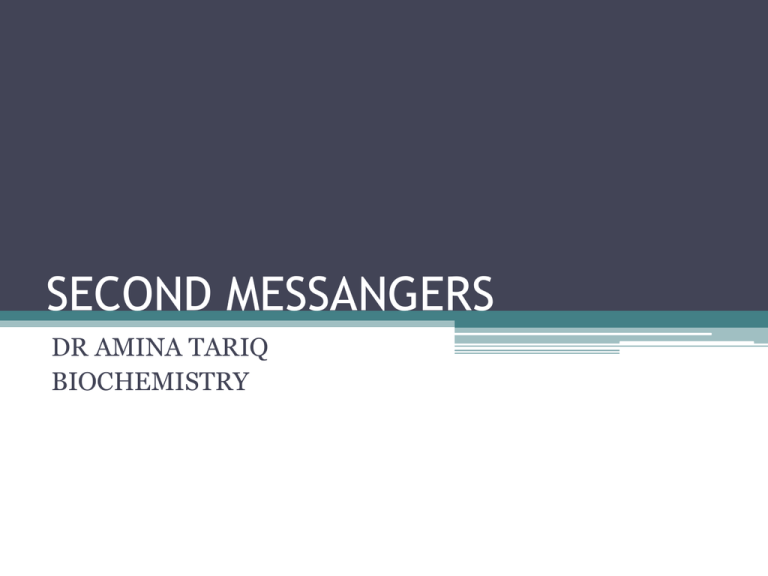
SECOND MESSANGERS DR AMINA TARIQ BIOCHEMISTRY Basic Characteristics Of Cell Signaling • Cell must respond appropriately to external stimuli to survive. • Cells respond to stimuli via cell signaling Each cell is programmed to respond to specific combinations of extracellular signal molecules Different cells can respond differently to the same extracellular signal molecule Signal Molecules and Receptors Some small hydrophobic hormones (steroid hormones) whose receptors are intracellular gene regulatory proteins Amino Acid Hormones • Amino acids cannot cross the cell membrane. • Amino acid hormones bind with a protein on the outside of the cell membrane A) General Steps: 1. Hormone Receptor 2. Effectors Enzyme 3. Second Messenger 4. Metabolic Responses Triggered G Protein–Coupled Receptors (GPCR) • These receptors typically have seven hydrophobic plasma membrane-spanning domains. • Many of the group II hormones bind to receptors that couple to effectors through a GTP-binding protein intermediary. Adenylyl Cyclase • Different peptide hormones can either stimulate (s) or inhibit (i) the production of cAMP from adenylyl cyclase • Two parallel systems, a stimulatory (s) one and an inhibitory (i) one, converge upon a catalytic molecule (C). • Each consists of a receptor, Rs or Ri, and a regulatory complex, Gs and Gi • Gs and Gi are each trimers composed of α, β and γ subunits. • Because the α subunit in Gs differs from that in Gi the proteins, which are distinct gene products, are designated s and i Hormones That Stimulate Adenylyl Cyclase (Hs • • • • • • • • • • • • ACTH ADH β 2-Adrenergics Calcitonin CRH FSH Glucagon hCG LH MSH PTH TSH Hormones That Inhibit Adenylyl Cyclase (HI) • Acetylcholine • α2-Adrenergics • Angiotensin II • Somatostatin • The αs protein has intrinsic GTPase activity. • The active form, αs·GTP, is inactivated upon hydrolysis of the GTP to GDP • the trimeric Gs complex (αβγ) is then re-formed and is ready for another cycle of activation. • Cholera and pertussis toxins catalyze the ADPribosylation of αs and α i-2 respectively. • In the case of αs, this modification disrupts the intrinsic GTPase activity; thus, αs cannot reassociate with and is therefore irreversibly activated. • ADP ribosylation of α i-2 prevents the dissociation of α i-2 from βγ , and free α i-2 thus cannot be formed. • αs activity in such cells is therefore unopposed. Second Messenger: Cyclic-AMP (cAMP) 1. Hormone Receptor (first messenger) • Hormone binds to the plasma membrane at a specific site. • Receptor protein changes shape and activates the G protein. 2. Effector Enzyme • G protein complex activates adenylate cyclase. • Adenylate cyclase breaks GTP to GDP. • Generates second messenger cyclic-AMP from ATP. Second Messenger • cyclic-AMP moves around the cell triggering chemical reactions with protein kinases. The second messenger is a kinase or phosphatase cascade: • • • • • • • • • • Chorionic somatomammotropin Epidermal growth factor Erythropoietin Fibroblast growth factor Growth hormone Insulin Insulin-like growth factors I and II Nerve growth factor Platelet-derived growth factor Prolactin Protein Kinase • cAMP binds to a protein kinase called protein kinase A (PKA) • It is a heterotrimeric molecule- 2 regulatory and 2 catalytic subunits. • cAMP binds to the regulatory subunit and catalytic is free and activated. • This catalytic subunit catalyzes the transfer of phosphate of ATP to other proteins, i.e. causes phosphorylation. Phosphoproteins • There are certain substrates for phosphorylation which defines a target tissue and the extent of a particular response within a given cell. • Control the effects of cAMP • The control of any of the effects of cAMP, including such diverse processes as steroidogenesis, secretion, ion transport, carbohydrate and fat metabolism, enzyme induction, gene regulation, synaptic transmission, and cell growth and replication, could be conferred by a specific protein kinase, by a specific phosphatase, or by specific substrates for phosphorylation. • CREB (cAMP response element binding protein)binds to CRE. • CREB binds to a cAMP responsive element (CRE) in its nonphosphorylated state and is a weak activator of transcription. • When phosphorylated by PKA, CREB binds the coactivator CREB-binding protein CBP/p300 and as a result is a much more potent transcription activator. Phosphodiestrases • They terminate the action of cAMP by its hydrolysis to 5´-AMP. • Thus they increase the intracellular signals and prolong the action of hormones through this signal. • These are subject to regulation by their substrates, cAMP and cGMP; by hormones; and by intracellular messengers such as calcium, probably acting through calmodulin. • Most significant inhibitors of phosphodiestrase are methylated xanthine derivatives such as caffeine Phosphatases • They are responsible for protein dephosphorylation. The second messenger is cGMP • Atrial natriuretic factor • Nitric oxide • NO – guanyl cyclase (soluble form) – GTP –cGMP – PKG- muscle relaxation • Atrial natriuretic peptide -guanyl cyclase (membrane bound form) – GTP –cGMP – PKG- natriuresis, diuresis, vasodilatation, inhibition of aldosterone secretion • Increased cGMP activates cGMP dependent protein kinase- protein kinase G which in turn phosphorylate the proteins • Muscle relaxation and dilatation of blood vessels • Nitroprusside, Nitroglycerin, Nitric oxide, sodium azide all are vasodilators. Second Messenger is Calcium or PI • • • • • • • • • Acetylcholine Angiotensin II Antidiuretic hormone Cholecystokinin Gastrin Gonadotrophin releasing hormone Oxytocin PDGF TRH • The extracellular calcium (Ca2+) concentration is about 5 mmol/L and is very rigidly controlled. Although substantial amounts of calcium are associated with intracellular organelles such as mitochondria and the endoplasmic reticulum, the intracellular concentration of free or ionized calcium (Ca2+) is very low: 0.05–10 mol/L • In spite of this large concentration gradient and a favorable trans-membrane electrical gradient, Ca2+ is restrained from entering the cell • prolonged elevation of Ca2+ in the cell is very toxic • Na+/Ca2+ exchange • Ca2+/proton ATPase-dependent pump that extrudes Ca2+ in exchange for H+ • Ca2+-ATPases pump Ca2+ from the cytosol to the lumen of the endoplasmic reticulum • There are three ways of changing cytosolic Ca2+: (1) Certain hormones by binding to receptors that are themselves Ca2+ channels, enhance membrane permeability to Ca2+ and thereby increase Ca2+ influx. (2) Hormones also indirectly promote Ca2+ influx by modulating the membrane potential at the plasma membrane. Membrane depolarization opens voltage-gated Ca2+ channels and allows for Ca2+ influx. (3) Ca2+ can be mobilized from the endoplasmic reticulum, and possibly from mitochondrial pools Enzymes and Proteins Regulated by Calcium or Calmodulin • • • • • Adenylyl cyclase Ca2+-dependent protein kinases Ca2+-Mg2+-ATPase Ca2+-phospholipid-dependent protein kinase Cyclic nucleotide phosphodiesterase • Some cytoskeletal proteins • Some ion channels (eg, L-type calcium channels) • Nitric oxide synthase • Phosphorylase kinase • Phosphoprotein phosphatase 2B • Some receptors (eg, NMDA-type glutamate receptor) • Calmodulin is a calcium dependent protein and it is similar to troponin C. • It has four binding sites for calcium. • Cell surface receptors such as those for acetylcholine, ADH and α1-catecholamines function through this pathway. • Their binding activates phospholipase C. • Phospholipase C catalyzes the hydrolysis of phosphatidylinositol 4,5 bisphosphate to inositol triphosphate(IP3) and 1,2 diacylglycerol. • 1,2 diacylglycerol activates protein kinase C (PKC). • PKC phosphorylate other substrates • IP3 causes the release of calcium from endoplasmic reticulum and mitochondria • The normal calcium ion concentration in most cells of the body is 10-8 to 10-7 mol/L, which is not enough to activate the calmodulin system. • But when the calcium ion concentration rises to 10-6 to 10-5 mol/L, enough binding occurs to cause all the intracellular actions of calmodulin. JAK-STAT pathway • • • • Growth hormone Prolactin Erythropoietin Cytokines All these activate cytoplasmic protein tyrosine kinases such as: Tyk-2, Jak-1or 2. NF-kB pathway • Extracellular stimuli such as pro inflammatory cytokines, reactive oxygen species and mitogens. • All these activate this pathway. • Glucocorticoid hormones are therapeutically used for the treatment of inflammatory and immune diseases. • These actions are modulated by the inhibition of NF-kB pathway. Tyrosine Kinase pathway • Insulin, epidermal growth factor and insulin like growth factor-I receptors have intrinsic protein tyrosine kinase activity. • The activation of a Tyrosine-Kinase Receptor occurs as follows: ▫ Two signal molecule binds to two nearby Tyrosine-Kinase Receptors, causing them to aggregate, forming a dimer ▫ The formation of a dimer activated the Tyrosine-Kinase portion of each polypeptide ▫ The activated Tyrosine-Kinases phosphorylate the Tyrosine residues on the protein
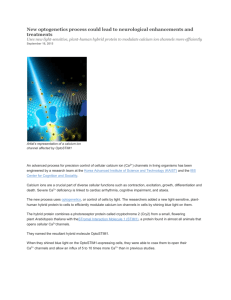
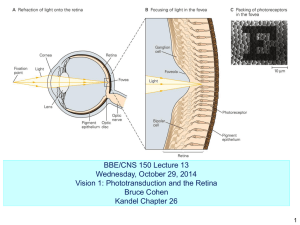
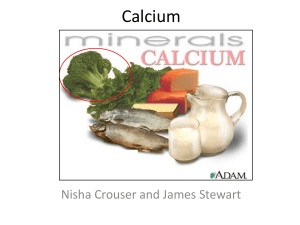
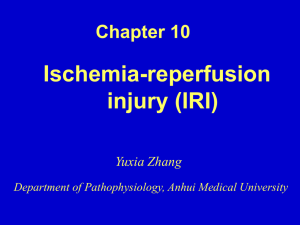
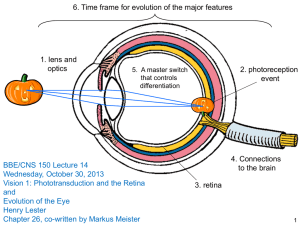
![Substantiation of the Rhod-2 as indicator of cytosolic [Ca2+] Rhod](http://s3.studylib.net/store/data/006893824_1-225923ad9f8cdb438dcdcf307ccbe9bd-300x300.png)
